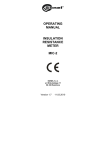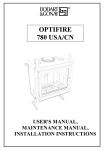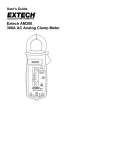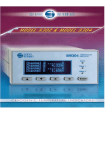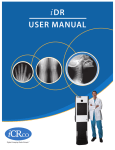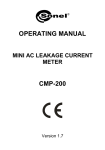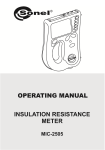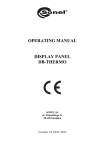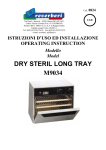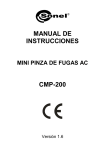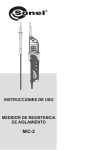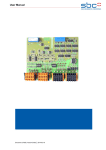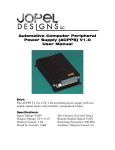Download User Manuals
Transcript
OPERATING INSTRUCTIONS P-1 indicator functionality includes: • AC/DC voltage indication, • Unipolar indication of phase, • Circuit continuity check, • Phase rotation indication, • RCD testing. L1 Probe L2 + L2 LED illuminating the measurement point 690 400 230 120 Unipol phase indicator LED voltage indicator RL 50 24 12 V Arrows indicating phase rotation Continuity indicatori (R<400kΩ) DC voltage polarization indicator (L2 probe) • Test the voltage indicator using a voltage source with known voltage value, Short circuit the probes – an audible signal should be generated and LED Ω should be lit. Touch electrode Note: The device can be used in rainy conditions, however at user’s own responsibility. It is recommended to use gauntlets. Illumination switch 2 Measurement electrode protector (placed on blades of both diameters) 2.1 Measurements Testing of the device Every time you want to use the device you need to check if it works properly: Note: Between the last measurement and the test you need a break of at least 240s. 2.4 Notes: Unipolar Phase Testing Voltage indication function is active also with discharged or removed batteries. All remaining functions require charged batteries. 2.2 AC and DC Voltage Testing Connect probe L2 to the tested object. Press the touch electrode. + L2 690 400 230 120 Connect both probes to the live object. RL LED being turned on indicates presence of voltage > 50V. 50 24 12 V + L2 L1 Voltage is shown on the LED indicator. 690 400 230 120 AC voltage is indicated by LED being turned on. RL 50 24 12 V For DC voltage, when probe L2 is connected to source’s “+”, LED is turned od, otherwise LED is turned on. Notes: Notes: AC voltage indicator P-1 Probe L1 Electrodes of varying diameter. Unscrewing the blade causes a reduction of the diameter of the electrode. To ensure correct utilization of the device and correctness of obtained results the following recommendations have to be adhered to: • Before you start to use the device read this instruction carefully and follow OHS standards and manufacturer’s recommendations. • Using the device for purposes other than described in this instruction can result in a damage or can be a source of a serious hazard for the user. • The device should be used only by persons suitably qualified and licenced to perform measurements in electrical installations. The device when used by unqualified persons, can become damaged or can be a source of a serious hazard for the user. • The device must not be used in dangerous environments e.g. where an explosion or fire hazards exist. • It is unacceptable to use the device if: ⇒ It is damaged and is partially or totally unusable, ⇒ Its test lead’s insulation is damaged, ⇒ It was stored for a prolonged period of time in unsuitable conditions (e.g. in high humidity). After the device is moved from a cold to warm environment, do not perform any measurements until the device reaches the ambient temperature (ca 30min). • You must not use the device while the battery compartment is fully or partially open and you must not use a power supply unit other than described in this instruction. • Measurements should not last longer than 30s. After a measurement that takes 30s, the subsequent measurement can be taken not earlier than after 240s. • Bounding values indication is intended as a warning feature and shouldn’t be used for measurements. • P-1 VOLTAGE INDICATOR P-1 Safety P-1 1 In networks secured with 10mA or 30mA RCDs, the RCD may get triggered while measuring the voltage between L and PE. To avoid this situation connect the device between L and N and after approx. 5s move the probe from N to PE. 2.3 RCD Testing In order to test an RCD with nominal current value of 10mA or 30mA you need to perform a voltage test between phase L and PE lead. Note! You must not touch the electrode of L1 test probe during phase testing. During unipolar phase testing the results can be incorrect if the user is too well insulated from the ground (e.g. while using insulated safety clothing or insulated work platform). Unipolar phase testing can be an insufficient method to determine if the circuit is live. You need to use a bipolar method. Circuit Continuity Test Note! The tested circuit may be live. Connect both probes to the tested circuit. An audible signal and activated LED Ω indicates that the circuit is continuous (R<400kΩ). Note: Voltage polarization on L2 probe is positive. 2.6 Phase Sequence Test L1 L1 L3 N Illumination of Measurement Point P-1 can provide illumination of the area around the point being measured. This is important in locations with poor light (e.g. in distribution substations). To turn on illumination press the but. ton marked 3 Battery Replacement The device is powered from two AAA 1.5V batteries. Absence of an audible signal after short circuiting of probes or weak illumination after pressing the button is an indication that the batteries need to be replaced. To do it follow the procedure below: Connect probe L1 to assumed phase L1 and probe L2 to assumed phase L2. Press the touch electrode. L2 PE 2.7 + L2 The voltage is shown on the LED indicator. P-1 2.5 690 400 230 120 LED R turned on indicates in-phase rotation. RL 50 24 12 V + OPEN LED L turned on indicates out of phase rotation . 4 CLOSE Cleaning and Maintenance P-1 After swapping the probes the opposite arrow should turn on. - Disconnect both probes from the tested circuit. - Using a tool or a coin unscrew the battery container by a counter clickwise movement and remove it. - Replace the battery paying attention to correct polarization. - Insert the container rotating it clockwise. NOTE! Use only maintenance methods that the manufacturer specified in this instruction. The device can be cleaned using a soft, damp cloth using generally accessible detergents. Do not use any solvents or cleaning agents that could scratch device’s housing (polishing powders, creams etc.). Notes: Phase sequence can be tested only in a 3 phase installation. Electronic circuitry is maintenance free. 5 Storage When storing the device you need to comply with the following guidelines: • Replace protective caps on the probes, • Make sure that the device is dry, • Decommissioned electrical equipment should be sent to an appropriate waste depot in compliance with legal acts governing electronic waste management.. s) Frequency range for bipolar phase rotation indicator: 50…60Hz t) Power supply: 2x1.5V AAA/LR03 u) Dimensions: ok. 240x60x30 mm v) Weight with batteries: ok. 0,2kg w) Working temperature: -10..+55°C x) Storage temperature: -30°C..+70°C y) Quality standards: design and manufacturing ISO 9001 compliant z) the product meets the EMC requirements (immunity for industrial environment) according to the following standards EN 613261:2006 and EN 61326-2-2:2006 Do not disassemble the equipment before sending it to a waste depot. 8 Follow local legislation regulating disposal of packaging and batteries. The manufacturer of the device and a provider of warranty and post-warranty services is: 6 If the device is to be stored for a prolonged period of time, remove the batteries. Decommissioning and Recycling Decommissioned electrical equipment should be stored separately from other type of waste. 7 Technical Specifications a) Type of insulation: double, EN 61010-1 compliant b) Safety category: III 1000V (IV 600V) as per EN 61010-1 c) Housing degree of protection as per EN 60529: IP65 d) Voltage range: 12…690V AC/DC e) Voltage indications: 12V, 24V, 50V, 120V, 230V, 400V, 690V f) input resistance Uin 12V, 24V, 50V 120V 230V 400V 690V Rin ~ 6kΩ ~ 20kΩ ~ 70kΩ ~ 150kΩ ~ 240kΩ g) Accuracy of voltage indications: as per EN 61243-3 h) Voltage frequency range: 0…400Hz i) Maximum current: IS<0,2A/IS(5s)<3,5mA j) Maximum work interval: 30s k) Minimum recovery time after being connected for 30s: 240s l) Minimum voltage triggering the device: <12V m) Voltage range for unipolar phase indicator: 50…690V n) Frequency range for unipolar phase indicator: 50…400Hz o) Continuity test range: 0…400kΩ p) Continuity test accuracy: ±50% q) Continuity test current: 3µA r) Voltage range for bipolar phase rotation indicator: 100…690V Manufacturer SONEL S. A. ul. Wokulskiego 11 58-100 Świdnica tel. (0-74) 858 38 60 (0-74) 858 38 00 fax (0-74) 858 38 08 e-mail: [email protected] internet: www.sonel.pl Note: The manufacturer is the only service provider authorized to provide repair the device. Note: The manufacturer reserves the right to introduce changes to device’s look, accessories and specifications. Version 1.7 23.02.2011



